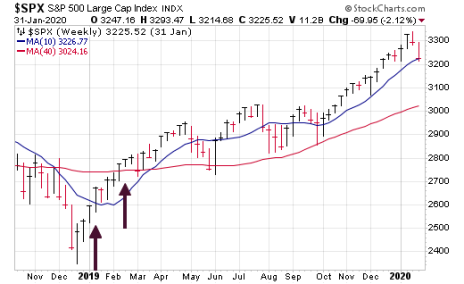To me, you’ll end up ahead of 75% of investors if you dedicate yourself to finding bullish market indicators and following the market’s trend, up or down, and not judging it. It’s a bit more complicated with individual stocks, where one piece of news (like earnings) can wreck an uptrend overnight. But even there, while I often take partial profits as a stock works its way higher, I always hold at least a piece of my original shares to sell “defensively”—i.e., on the way down, after the trend has turned, thus giving my portfolio a chance to benefit from huge winners.
One of the big advantages of being a trend follower is that I don’t have to worry much about the dozens of overbought/oversold market indicators out there—from MACD to RSI to Bollinger Bands to Stochastics and many more that supposedly tell you when a stock has gone too far, too fast.
[text_ad]
However, there is one aspect of the overbought/oversold equation that I pay a great deal of attention to, partly because it runs contrary to what most investors believe. The concept was stated best by the now-retired technician Walter Deemer, who wrote a short (but great) “idea” book last year called When the Time Comes to Buy, You Won’t Want To, which included more than 60 market truisms.
My favorite of the bunch: “The Market Gets the Most Oversold at the Bottom and the Most Overbought at the Beginning of an Advance.” That’s right—it turns out that when the market becomes extremely, extremely overbought, it’s usually early in a new advance.
Over time, I’ve followed a handful of bullish market indicators that indicate highly unusual strength in the market; I call them “blastoff indicators,” for obvious reasons. The signals don’t come often—many flash just once every five to 10 years—but when they do, they almost always point to good things down the road.
The reason they work is actually simple: Very unusual strength occurs because there’s a sudden positive change in investor perception. That’s like a big boulder dropped into a lake, with ripple effects that take time to play out.
Why focus on this now? Because these blastoff signals are often flashed after a big market decline—which is something we’ve been seeing in growth stocks and are now seeing in the broader indexes, with the S&P 500 having fallen 9% YTD. There are many out there, but I like to stick with a handful.
My Favorite Bullish Market Indicators
The first and my favorite is the 2-to-1 Blastoff indicator, which was likely invented by Walter Deemer (though I read about it first from the late, great Marty Zweig, so I’m not really sure who gets the credit). It happens when, over a span of 10 trading days, the NYSE Advance-Decline Line averages a positive 2-to-1 reading. Translation: Over two weeks, every day averages at least twice as many advancing stocks as declining stocks.
The last time this happened was back on January 9, 2019, just as the market was taking off from its late-2018 market correction (first arrow in the chart below). That led to 13 months of great performance, of course, and that wasn’t unusual—there have been just a couple dozen or so signals since 1960 (!), and the market gained as much as 25% a year later on average. More than that, the signals usually came at or near the start of major bull markets.
Another of my favorite bullish market indicators is the 90% Blastoff indicator, which flashes when 90% of NYSE stocks rise above their respective 50-day moving averages at the same time. It flashed back in late February 2019 (second arrow in the chart) and again in June of 2020 (on the heels of the pandemic sell-off), and not only does it lead to good gains looking out a year (20%-ish max gain on average), but drawdowns after these signals tend to be minimal (2% or so), despite the fact that the signals often come a couple of months after a market bottom.
There are other “quicker” measures I track, such as the 10-day blastoff (90% of stocks get above their 10-day moving average) and the Whaley Breadth Thrust (named after Wayne Whaley, it occurs when the five-day A-D Line averages 2.8-to-1), but the above two are my favorite.
With the market in something of a repair phase right now, and growth stocks (in particular) trying to build a workable bottom, when the dust settles, be on the lookout for these bullish market indicators. When they flash, it’s usually a signal to start buying stocks again.

Learn More

Learn More

Learn More

Learn More
*This post has been updated from an original version, published in 2020.


